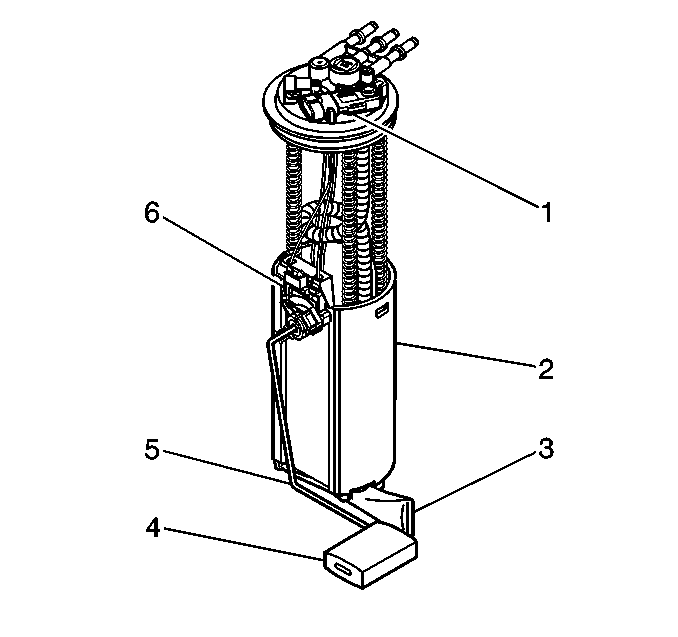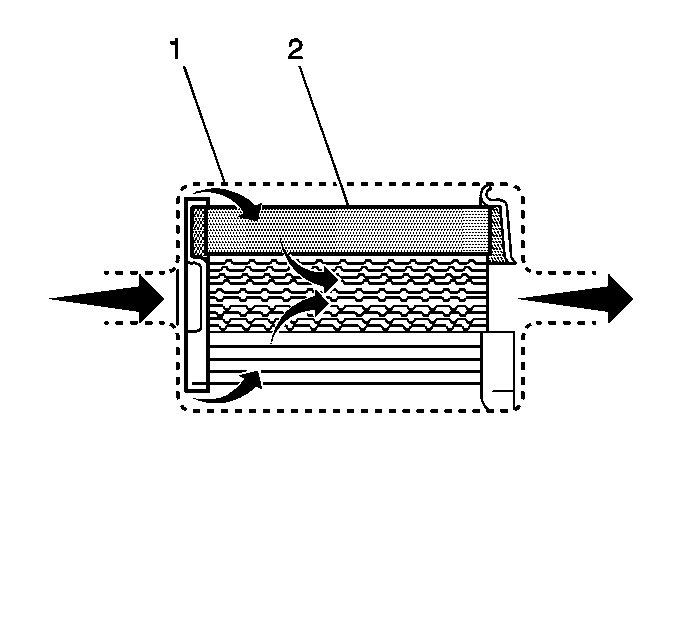Fuel Tank
The fuel tank, at the rear of the underbody, is held in place by two metal straps. Insulators are used on the fuel tank in order to reduce rattles.
Fuel Balance Control System (Dual Tanks)
The fuel balance control system consists of the following components:
| • | Front, or main, fuel tank sender |
| • | Rear, or auxiliary, fuel tank sender |
| • | Balance fuel pump |
| • | Balance fuel pump relay |
| • | Fuel sender and balance module |
On vehicles with dual tanks, the front tank is the main and the rear tank is the auxiliary. The main fuel balance pump supplies fuel to the fuel injection unit. The low pressure, about 32 kPa (7 psi) fuel balance pump is used only to transfer fuel from the auxiliary tank to the main tank in order to balance the fuel levels in both tanks. As the main tank level drops to about 25 percent below the level in the auxiliary tank, the fuel sender and balance module energizes the fuel pump relay. This pumps the fuel from the auxiliary tank to the main tank. When the level in the main tank reaches a level slightly higher than the level in the auxiliary tank, or the auxiliary tank is empty, the module de-energizes the balance pump relay and fuel pump. Any malfunction in either of the fuel gauge circuits will disable the system and the fuel will not be transferred from the auxiliary fuel tank to the main fuel tank.
Fuel Fill Pipe
The fuel fill pipe on gasoline engine equipped vehicles has a built-in restrictor and deflector In order to help prevent refueling with leaded gasoline. The opening in the restrictor will only admit the smaller unleaded gas nozzle spout, which must be fully inserted to bypass the deflector. Attempted refueling with a leaded gas nozzle or failure to fully insert the unleaded gas nozzle results in gasoline splashing back out of the filler neck.
Fuel Filler Cap
The fuel fill pipe has a tethered fuel filler cap. Turn the cap counterclockwise in order to remove it. A built-in torque-limiting device prevents overtightening. In order to install the cap, turn the cap clockwise until a clicking noise is heard. The clicking is a signal to the operator that the correct torque has been reached and the cap is fully seated.
Fuel Sender Assembly

The fuel sender assembly is inside the fuel tank attached to the top of the fuel tank. The fuel sender assembly consists of the following major components:
| • | The fuel level sensor (6) |
| • | The fuel tank pressure sensor (1) |
| • | The fuel tank fuel pump module (2) |
| • | The fuel strainer (3) |
Fuel Pump
The fuel pump attaches to the fuel sender assembly reservoir inside the fuel tank. The fuel pump is an electric high pressure pump. The fuel pump pumps fuel to the fuel meter body assembly at a specified flow and pressure. Excess fuel from the fuel meter body returns to the fuel tank through the fuel return pipe. The fuel pump delivers a constant flow of fuel to the engine even during low fuel conditions and aggressive vehicle maneuvers. The control module controls the electric fuel pump operation through a fuel pump relay. The fuel pump flex pipe acts to dampen the fuel pulses and noise generated by the fuel pump.
Fuel Strainer
The fuel strainer attaches to the lower end of the fuel sender assembly. The fuel strainer is made of woven plastic. The functions of the strainer are to filter contaminants and to wick fuel. The fuel strainer normally requires no maintenance. Fuel stoppage at this point indicates that the fuel tank contains an abnormal amount of sediment or water. Clean the fuel tank and replace a plugged strainer with a new one.
In-Line Fuel Filter

The fuel feed pipe has a steel fuel filter installed ahead of the fuel injection system. The paper filter element (2) traps particles in the fuel that may damage the injection system. The filter housing (1) is made to withstand maximum fuel system pressure, exposure to fuel additives, and changes in temperature.
Nylon Fuel and EVAP Pipes
Nylon fuel pipes are designed to perform the same job as the steel or flexible fuel pipes or hoses that they replace. Nylon pipes are constructed to withstand maximum fuel system pressure, exposure to fuel additives, and changes in temperature. There are three sizes of nylon pipes used: 3/8 in. ID for the fuel feed, 5/16 in. ID for the fuel return and 1/2 in. ID for the vent. Heat resistant rubber hose and/or corrugated plastic conduit protect the sections of the pipes that are exposed to chafing, high temperature, or vibration.
Nylon fuel pipes are somewhat flexible and can be formed around gradual turns under the vehicle. However, if nylon fuel pipes are forced into sharp bends, the pipes will kink and restrict the fuel flow. Also, once exposed to fuel, nylon pipes may become stiffer and are more likely to kink if bent too far. Take special care when working on a vehicle with nylon fuel pipes.
Quick-Connect Fittings
Quick-connect type fittings provide a simplified means of installing and connecting the fuel system components. The fittings consist of a unique female connector and a compatible male pipe end. O-rings, located inside the female connector, provide the fuel seal. Integral locking tabs or fingers hold the fittings together.
Fuel Pipe O-Rings
O-rings seal the threaded connections in the fuel system. Fuel system O-ring seals are made of special material. Service the O-ring seals with the correct service part.
EVAP Pipes and Hoses
The evporative emission (EVAP) pipes extend from the fuel sender assembly and the EVAP canister to the EVAP purge solenoid in the engine compartment. The EVAP pipes are made of nylon. The EVAP vent solenoid connects to the EVAP canister with a section of fuel resistant rubber hose.
